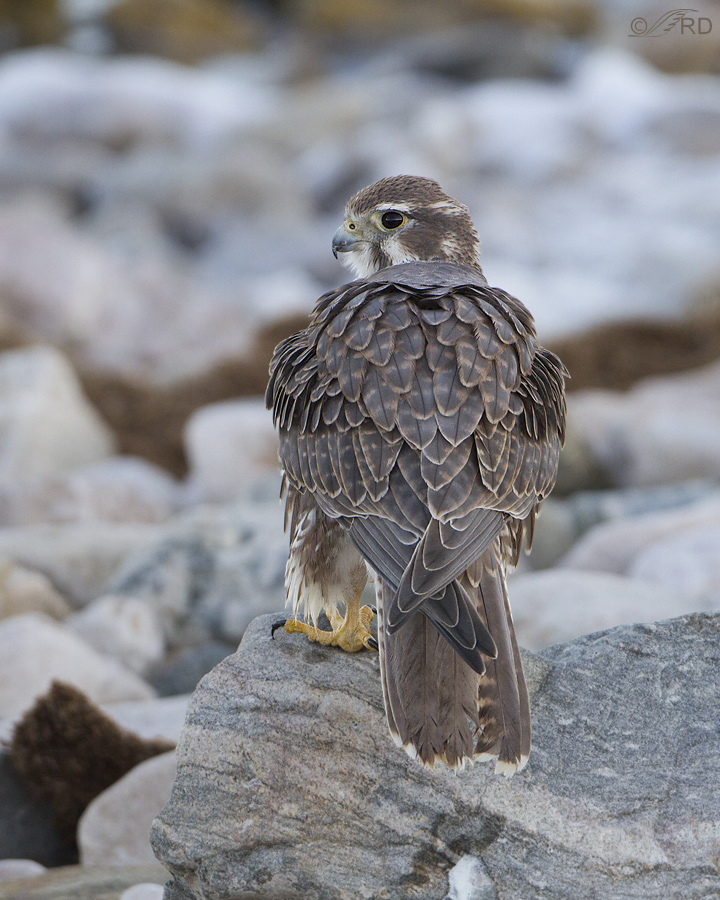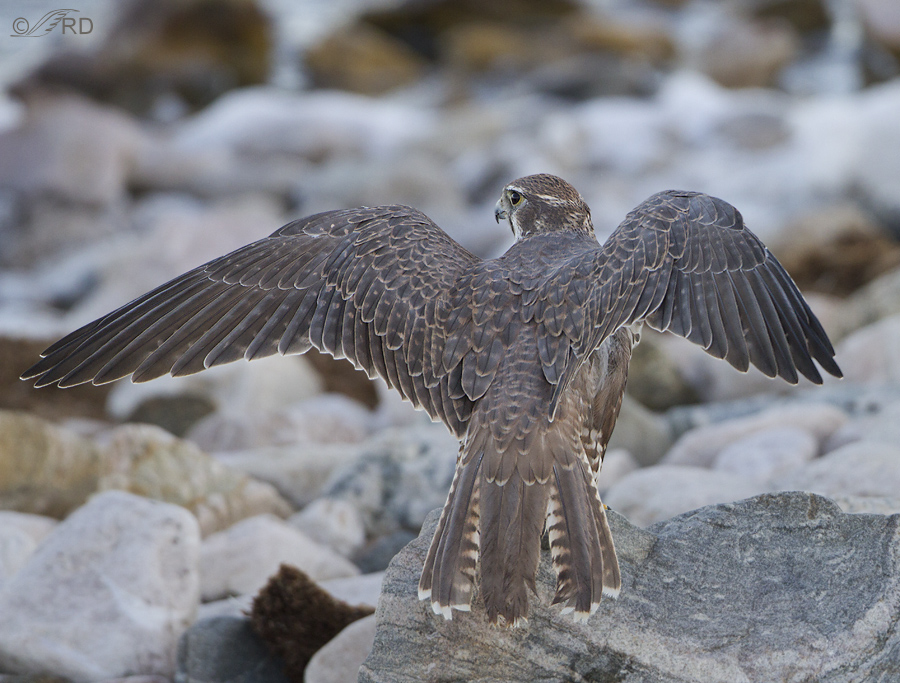Last month, this Prairie Falcon let me get very close to it on the causeway to Antelope Island. It was in early morning and the bird was in deep shade. It’s my impression that they feel less threatened in that kind of light and though it makes for very difficult photography, I’ll take the bird close in poor light, instead of a mile away in gorgeous light – any ol’ day of the week.

1/640, f/4.5, ISO 640, 500 f/4, natural light, not baited, set up or called in
Previously, I’ve posted a different image of this bird but that one didn’t have the textures provided by the raised feathers that we see here.

1/800, f/4.5, ISO 640, 500 f/4, natural light, not baited, set up or called in
When this bird decided it was time to leave it had a bit of a pleasant surprise for me. In this light and with this slow shutter speed I could never get the bird sharp as it took off but just before it launched, it spread its wings and held them there for a few seconds and it even glanced back enough for me to get some light in the eye.
But what I like most about this image is the great look at the feather patterns on the left wing and back. Because of the spread wing and the lightly colored margins on each feather, those patterns are very clear and it is easy to delineate each plumage “group” – primaries, secondaries, primary coverts, greater coverts, median coverts, lesser coverts, alula, scapulars, mantle and nape. All very useful information to serious birders and bird photographers, though probably less interesting to many casual birders.
I plan to use this image to learn feather groupings better – something I’ve procrastinated on for too long now…
Ron


Prairies are awesome Ron! We’re so lucky to have them around here, and within your camera range. My vote is that this a completely molted adult that can’t be definitively sexed from these 2 pics (although I’ll guess male), and can’t be aged with any certainty beyond “after hatch year” (bander’s terms) or “after first year” (normal speak). It might be a very wise old bird, but since there’s only one generation of adult feather present, it can’t be said with certainty that it’s in it’s first adult plumage or fifth.
The central tail feathers are indeed new this year, but appear overly thrashed because they were the first ones replaced way back in the spring when the molt cycle began, and have had the most exposure to wear and tear and sun fading. Fortunately they’ll be the first feathers replaced when molt restarts again in the spring.
The second* outer primaries (more formally known as P9) aren’t as short as they appear. They only look so due to the way the sun shines off the leading edge of the vane where it tapers into the finger. It’s easier to see the complete feather on the left wing than the right. If they were indeed incompletely molted feathers, then this Prairie would have 11 primaries on each wing instead of the normal 10. *Primary #2 (P2) is actually located down lower on the inner wing, but I think Louise and I are referring to the same feather.
These pictures are also a great way of illustrating the way falcon molt differs from hawks and eagles, but that’s way too geeky to blab on about. Lol. Thanks for posting them and bringing up the subject- aging birds on your blog is a great alternative to sudoku!
Thanks very much Mike. All this is very helpful to my “education”. Perhaps one day you’ll be able to include those differences you mention between the molts of falcons and those of hawks and eagles.
Funny that you should mention Sudoku here – my cousin and best friend, Ken Dudley,was addicted to it, though it never really appealed to me. When Ken passed away (much too young) a few years ago, he left me a small inheritance that allowed me to purchase the 500 f/4. Without him I’d never be photographing birds.
Looks like the bird still had some molting to do on the tail – the deck feathers look pretty worn. Looks like maybe the second primary on each wing isn’t completely in either. Lovely rouse, though, in the first shot!
I hadn’t even noticed those two shorter primaries, Louise. Thanks.
Now thats what I call great figure ground relationship. You should have been an art teacher . Perhaps you are one now . Thanks again..
Thanks Eldridge, But I don’t even know what a “figure ground relationship” is. I honestly don’t. I’m assuming I just got lucky…
beautiful bird, so well concealed and so nicely photograped!
“Well concealed” is right, Tana. I dang near missed him/her. Thank you.
Wonderful as always, Ron. As a serious (i.e., geeky)raptorphile, I REALLY like these images for exactly the reasons you state – the feather tracts and their markings are clearly displayed. Although we can tell this is an adult by its yellow orbital ring and cere, your pictures also show the the pale barring on the back feathers and upperwing coverts – characteristic of adult birds. Juvenile birds lack that barring, so their backs appear darker than adults’ – a good field mark for differentiation. Finally, the second image clearly shows yet another feather grouping, the axillaries (“armpit” feathers) on its right side, not often seen from the rear. As you know, dark axillaries (and underwing coverts)are THE most commonly mentioned field mark for Prairie Falcons. Sorry for the geekiness – these are superb “teaching” photos of a beautiful bird. Thanks!

I loved your “geekiness”, Dick. I wanna be more like you!
This “teacher” loved being on the other end of your lesson. Thanks for that.
Just beautiful! Thank you for doing what you do! We are all enriched.
I appreciate your encouragement, Mikal. Lots.